Question
How many persons sit between S and
R? Answer the questions based on the information given below. Eight persons P, Q, R, S, T, U, V and W are sitting around a circular table facing inside but not necessarily in the same order. All of them likes different flowers viz. Lily, Rose, Marigold, Daisy, Jasmine, Lavender, Lris and Pansy but not necessary in same order. Only one person sits between T and the one who likes Lily. P sits second to the left of the one who likes Lily. W is an immediate neighbour of R. R is not an immediate neighbour of P or T and he does not likes Lavender. T sits second to the left of the one who likes Lavender. Only three people sit between the one who likes Rose and the one who likes Marigold. U sits second to the left of the one who likes Marigold. W does not likes Daisy. The one who likes Daisy is not an immediate neighbor of W. S sits on the immediate left of the one who likes Daisy. The one who likes Lris sits on the immediate right of the one who likes Pansy. Only two persons sit between V and the one who has likes Lavender. The one who likes Rose sits second to the right of W.Solution
Only one person sits between T and the one who likes Lily. P sits second to the left of the one who likes Lily. If the one who likes Lily sits at place no.1, then P sits at place no. 7 and T sits at place no. 3. T sits second to the left of the one who likes Lavender. So, the one who likes Lavender at place no. 5. 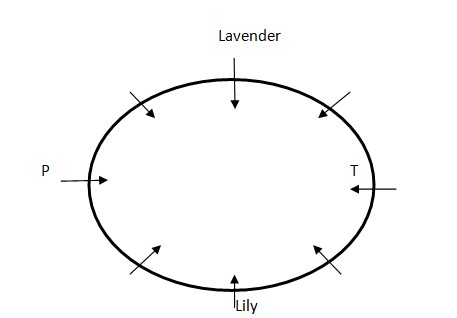 Only two persons sit between V and the one who has likes Lavender. From this statement, we will have two cases: V will sit either at place no. 2 or 8. W is an immediate neighbour of R. R is not an immediate neighbour of P or T and he does not likes Lavender. The one who likes Rose sits second to the right of W. R cannot sit at place no. 6, 5, 4 and 8. So, only place left for him is place no. 1. As W is an immediate neighbour of R. So, W will sit either at place no. 8 or 2. The one who likes Rose sits either at place no. 4 or 2. Only three people sit between the one who likes Rose and the one who likes Marigold. So, the one who likes Marigold sits either at place no. 6 or 8. U sits second to the left of the one who likes Marigold. So, U sits either at place no. 4 or 6. Case-1
Only two persons sit between V and the one who has likes Lavender. From this statement, we will have two cases: V will sit either at place no. 2 or 8. W is an immediate neighbour of R. R is not an immediate neighbour of P or T and he does not likes Lavender. The one who likes Rose sits second to the right of W. R cannot sit at place no. 6, 5, 4 and 8. So, only place left for him is place no. 1. As W is an immediate neighbour of R. So, W will sit either at place no. 8 or 2. The one who likes Rose sits either at place no. 4 or 2. Only three people sit between the one who likes Rose and the one who likes Marigold. So, the one who likes Marigold sits either at place no. 6 or 8. U sits second to the left of the one who likes Marigold. So, U sits either at place no. 4 or 6. Case-1 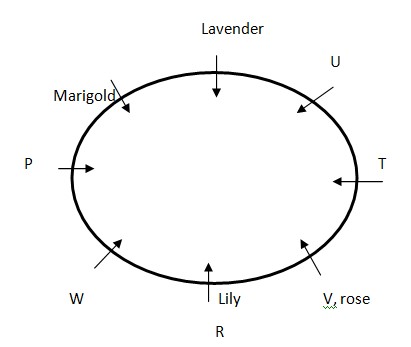 CASE-2
CASE-2 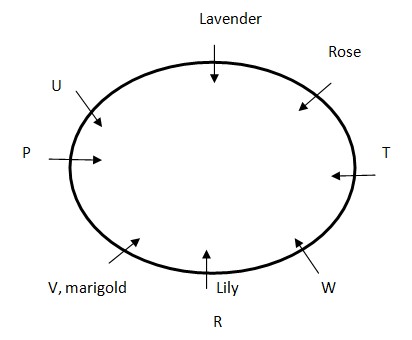 W does not likes Daisy. The one who likes Daisy is not an immediate neighbor of W. S sits on the immediate left of the one who likes Daisy. The one who likes Lris sits on the immediate right of the one who likes Pansy. Case 1 will get discarded as the one who likes Daisy cannot sit at place no. 7 and 8. If the one who likes Daisy sits either at place no. 4 or 3, then there is no place for S as S sits on the immediate left of the one who likes Daisy In case 2, if the one who likes Daisy sits at place no. 6, then S sits at place no. 5. The one who likes Lris and the one who likes Pansy sit at place no. 3 and 2 respectively Only person left for place no. 4 is Q. Only flowers left for P is Jasmine Case-1
W does not likes Daisy. The one who likes Daisy is not an immediate neighbor of W. S sits on the immediate left of the one who likes Daisy. The one who likes Lris sits on the immediate right of the one who likes Pansy. Case 1 will get discarded as the one who likes Daisy cannot sit at place no. 7 and 8. If the one who likes Daisy sits either at place no. 4 or 3, then there is no place for S as S sits on the immediate left of the one who likes Daisy In case 2, if the one who likes Daisy sits at place no. 6, then S sits at place no. 5. The one who likes Lris and the one who likes Pansy sit at place no. 3 and 2 respectively Only person left for place no. 4 is Q. Only flowers left for P is Jasmine Case-1 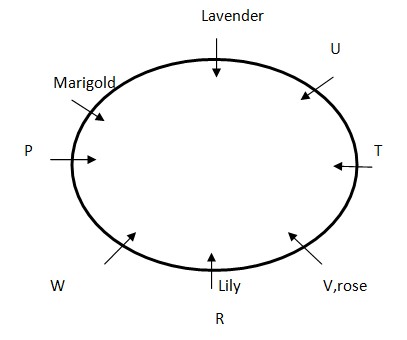 CASE-2
CASE-2 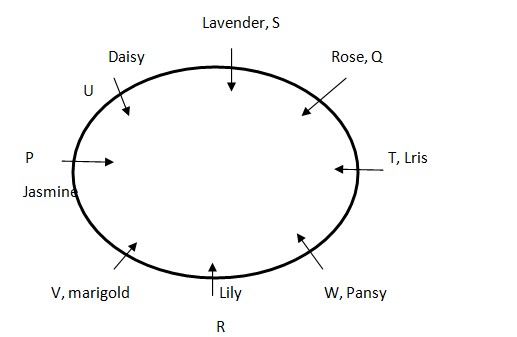 Final arrangement as shown below:
Final arrangement as shown below:
Select the combination of letters that when sequentially placed in the blanks of the given letter series will complete the series.
p _ q q q _...
From the given alternatives select the word which cannot be formed using the letters of the given word
SIMULTANEOUSLY
The second number in the given pairs is obtained by performing some mathematical operation(s) on the first number. The same operation(s) is/are followed...
If all the letters in the word ‘LEAVING’ are arranged in alphabetical order from left to right such that the vowels are arranged first followed by...
How many alphabets are there between the 6th letter from the left end and 3rd letter from the right end after the rearrangement as...
How is V related to U’s mother?
If each letter in each of the word is arranged according to the alphabetical series, than which is the third letter of the word, which is fourth from th...
Select the number combination of letters that when placed sequentially in the blanks of the given series will complete the series.
G G G _ _ G H ...
Which one of the following will be the last but one when arranged according to the English Alphabetical Dictionary?
There are five student Z, V, T, J and H scored different marks. Z scores more than J but less than V. T scores less than V but more than H, who score mo...
Relevant for Exams:


